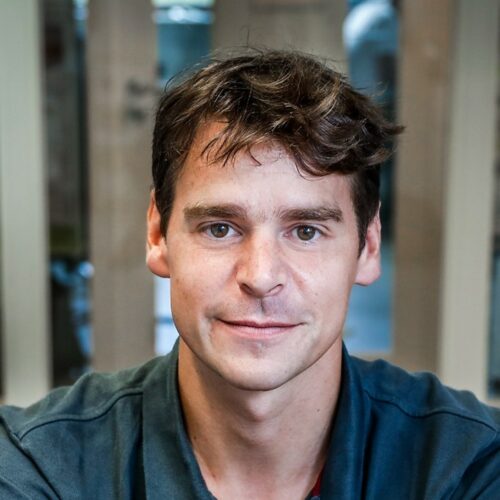Michiel Dusselier
KU Leuven"Reshaping the role of CO2 in propane dehydrogenation, from waste gas to platform chemical"

“Reshaping the role of CO2 in propane dehydrogenation, from waste gas to platform chemical”
The increasingly growing demand for propylene, due use in the polymer and rubber industry, has resulted in substantial attention into the study of the dehydrogenation of propane.[1] Propane dehydrogenation (DHP) is an attractive alternative method as it produces only propylene on-demand (no mixed product stream) from inexpensive shale-gas propane. [1,2] Oxidative propane dehydrogenation (ODHP) has been suggested an alternative to traditional DHP to decrease catalyst deactivation due to coke formation and remove thermodynamic limitations.[3] However, the challenge of the complete oxidation of propane and propene to carbon oxides is present when using O2. The use of carbon dioxide (a much weaker oxidant) can counteract this issue whilst also acting as a greener alternative with abundant availability at cheaper cost.4 Coupling CO2 reduction with propane dehydrogenation boosts conversion and produces CO, a valuable platform chemical currently synthesized by fossil-methane reforming. In this presentation, (i) we demonstrate the environmental benefits of coupling CO2 with a life-cycle assessment under industrial conditions, potentially reducing emissions by 3 tCO2-eq per ton of propylene produced. (ii) We show a screening of supported catalytic materials─both known and novel─with a focus on propane and CO2 reaction mechanisms under industrial reaction conditions of 400–700 °C and pressures of 1–6 barg. We evaluate each material under the kinetic regime, and we quantify reaction, side reaction, and deactivation kinetics (coking, cracking, and dry-reforming), as well as the regeneration ability. We try to classify them based on their dominant mechanisms (direct CO2 assistance or indirect with H2 via reverse water gas shift) and identify each catalyst’s strengths and weaknesses. We then (iii) correlate our database of experimental results of 22 active metals/metal oxides with the Tamman temperature and density functional theory (DFT)-based oxygen vacancy formation energies. We discovered that oxygen mobility plays a crucial role in the kinetics of reoxidation with CO2 and the overall balance of active sites related to dehydrogenation and reoxidation.[10]
As a final part of this talk, iv) I show how to translate these bulk alumina-supported catalysts into confined zeolite-systems. Zeolites are attractive catalysts in the petrochemical industry as the ring systems can hinder coke formation and improve catalytic stability. Hence, there is interest in developing zeolite catalysts for DHP and a variety of zeolite catalysts have been tested so far including chromium[5] and vanadium[6] oxides on MCM-41 and ZnO[7] on ZSM-5. Propane conversion and selectivity was found to be high over some of these systems, though currently a limited number of frameworks have been tested. Small-pore zeolites are gaining momentum due to the recent implementation of these catalysts in methanol-to-olefins[8] and selective catalyst reduction processes.[9] Nevertheless, these frameworks have not yet been tested for ODHP. The use of vanadium oxides (and similar direct mechanism metals) impregnated on small-pore zeolites is really interesting for ODHP using CO2. We investigate the nature of the V active site and show remarkably high activity and stability in V/CHA.[11]
The overall message [10,11] is that the role of CO2 in PDH can be be reshaped, and that there is much more to the story than avoiding coke and increasing stability.
[1] S. Chen, X. Chang, G. Sun, T. Zhang, Y. Xu, Y. Wang, C. Pei and J. Gong, Chem. Soc. Rev., 2021, 50, 3315–3354. [2] Z. Xu, Y. Yue, X. Bao, Z. Xie and H. Zhu, ACS Catal., 2020, 10, 818–828. [3] C. Carrero, R. Schloegl, I. Wachs and R. Schomaecker, ACS Catal., 2014, 4, 3357. [4] D. Mukherjee, S.-E. Park and B. M. Reddy, J. CO2 Util., 2016, 16, 301–312. [5] D. He, Y. Zhang, S. Yang, Y. Mei and Y. Luo, ChemCatChem, 2018, 10, 5434. [6] S. Sokolov, M. Stoyanova, U. Rodemerck, D. Linke and E. V Kondratenko, J. Catal., 2012, 293, 67–75. [7] F. Zhang, C. Miao, Y. Yue, W. Hua and Z. Gao, Chin. J. Chem., 2012, 30, 929–934. [8] Dusselier, Davis, Chem. Rev. 2018 , 118, 11, 5265–5329 [9] J. H. Kwak, R. G. Tonkyn, D. H. Kim, J. Szanyi and C. H. F. Peden, J. Catal., 2010, 275, 187–190. [10] M. Rigamonti, M. Shah, T. Gambu, M. Saeys, M. Dusselier ACS Catal., 2022 12, 9339-9358. [11] Shah, M.; Rigamonti, M., Mendoza-Mesa, J., Donckels, T., Eloy, P., Debecker, D.P., Dusselier M. in Submission
Prof. Michiel Dusselier co-founded the Center for Sustainable Catalysis and Engineering (CSCE) at KU Leuven. He is focusing on zeolite synthesis, reactor design, degradable plastics and heterogeneous catalysis (CO2). In particular, he is enthusiastic about elaborate synthesis-structure-activity relations and bottom-up catalyst design, as e.g. explored in the ERC starting Grant ‘Z-EURECA’.